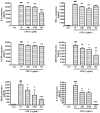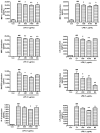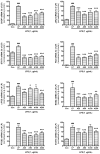Anti-Inflammatory Effects of Angelica sinensis (Oliv.) Diels Water Extract on RAW 264.7 Induced with Lipopolysaccharide
- PMID: 29883374
- PMCID: PMC5986526
- DOI: 10.3390/nu10050647
Anti-Inflammatory Effects of Angelica sinensis (Oliv.) Diels Water Extract on RAW 264.7 Induced with Lipopolysaccharide
Abstract
The dry root of Angelica sinensis (Oliv.) Diels, also known as “female ginseng”, is a popular herbal drug amongst women, used to treat a variety of health issues and cardiovascular diseases. The aim of this study is to evaluate the detailed molecular mechanism for anti-inflammatory effects of Angelica sinensis root water extract (ASW). The anti-inflammatory effect of ASW on lipopolysaccharide (LPS)-induced RAW 264.7 mouse macrophages was evaluated by the tetrazolium-based colorimetric assay (MTT), Griess reagent assay, multiplex cytokine assay, real time reverse transcription polymerase chain reaction (RT-PCR), and Fluo-4 calcium assay. ASW restored cell viability in RAW 264.7 at concentrations of up to 200 µg/mL. ASW showed notable anti-inflammatory effects. ASW exhibited IC50 = 954.3, 387.3, 191.7, 317.8, 1267.0, 347.0, 110.1, 573.6, 1171.0, 732.6, 980.8, 125.0, and 257.0 µg/mL for interleukin (IL)-6, tumor necrosis factor (TNF)-α, monocyte chemotactic activating factor (MCP)-1, regulated on activation, normal T cell expressed and secreted (RANTES), granulocyte colony-stimulating factor (G-CSF), granulocyte macrophage colony-stimulating factor (GM-CSF), vascular endothelial growth factor (VEGF), lipopolysaccharide-induced CXC chemokine (LIX), macrophage inflammatory protein (MIP)-1α, MIP-1β, MIP-2, IL-10, and intracellular calcium, respectively. Additionally, ASW inhibited the LPS-induced production of nitric oxide and the LPS-induced mRNA expression of CHOP (GADD153), Janus kinase 2 (JAK2), signal transducers and activators of transcription 1 (STAT1), first apoptosis signal receptor (FAS), and c-Fos, NOS2, and PTGS2 (COX2) in RAW 264.7 significantly (p < 0.05). Data suggest that ASW exerts an anti-inflammatory effect on LPS-induced RAW 264.7 via NO-bursting/calcium-mediated JAK-STAT pathway.
Keywords: Angelica sinensis; JAK-STAT; anti-inflammatory; calcium; cytokine; macrophage; nitric oxide.
Conflict of interest statement
The authors declare no conflict of interest. The founding sponsors had no role in the design of the study; in the collection, analyses, or interpretation of data; in the writing of the manuscript, and in the decision to publish the results.
Figures






Similar articles
-
Ethanol extract from a Chinese herbal formula, "Zuojin Pill", inhibit the expression of inflammatory mediators in lipopolysaccharide-stimulated RAW 264.7 mouse macrophages.J Ethnopharmacol. 2012 May 7;141(1):377-85. doi: 10.1016/j.jep.2012.02.049. Epub 2012 Mar 6. J Ethnopharmacol. 2012. PMID: 22414473
-
Rubi Fructus Water Extract Alleviates LPS-Stimulated Macrophage Activation via an ER Stress-Induced Calcium/CHOP Signaling Pathway.Nutrients. 2020 Nov 22;12(11):3577. doi: 10.3390/nu12113577. Nutrients. 2020. PMID: 33266427 Free PMC article.
-
Baicalin Modulates Inflammatory Response of Macrophages Activated by LPS via Calcium-CHOP Pathway.Cells. 2022 Sep 30;11(19):3076. doi: 10.3390/cells11193076. Cells. 2022. PMID: 36231038 Free PMC article.
-
Danggui to Angelica sinensis root: are potential benefits to European women lost in translation? A review.J Ethnopharmacol. 2014 Feb 27;152(1):1-13. doi: 10.1016/j.jep.2013.12.018. Epub 2013 Dec 21. J Ethnopharmacol. 2014. PMID: 24365638 Review.
-
Exploring the Pivotal Immunomodulatory and Anti-Inflammatory Potentials of Glycyrrhizic and Glycyrrhetinic Acids.Mediators Inflamm. 2021 Jan 7;2021:6699560. doi: 10.1155/2021/6699560. eCollection 2021. Mediators Inflamm. 2021. PMID: 33505216 Free PMC article. Review.
Cited by
-
Burn Ointment Promotes Cutaneous Wound Healing by Modulating the PI3K/AKT/mTOR Signaling Pathway.Front Pharmacol. 2021 Mar 8;12:631102. doi: 10.3389/fphar.2021.631102. eCollection 2021. Front Pharmacol. 2021. PMID: 33762951 Free PMC article.
-
An exhaustive examination of the research progress in identifying potential JAK inhibitors from natural products: a comprehensive overview.Chin Med. 2025 Aug 21;20(1):130. doi: 10.1186/s13020-025-01176-0. Chin Med. 2025. PMID: 40841966 Free PMC article. Review.
-
Metabolomics study of Angelica sinensis (Oliv.) Diels on the abnormal uterine bleeding rats by ultra-performance liquid chromatography-quadrupole-time-of-flight mass spectrometry analysis.Food Sci Nutr. 2021 Oct 13;9(12):6596-6609. doi: 10.1002/fsn3.2605. eCollection 2021 Dec. Food Sci Nutr. 2021. PMID: 34925789 Free PMC article.
-
Xiaoyao powder alleviates the hippocampal neuron damage in chronic unpredictable mild stress-induced depression model rats in hippocampus via connexin 43Cx43/glucocorticoid receptor/brain-derived neurotrophic factor signaling pathway.Bioengineered. 2022 Jan;13(1):383-394. doi: 10.1080/21655979.2021.2005744. Bioengineered. 2022. PMID: 34984950 Free PMC article.
-
The molecular mechanism of GADD153 in apoptosis of keloid fibroblasts exposed to botulinum toxin type A.J Cell Mol Med. 2021 Oct;25(19):9402-9410. doi: 10.1111/jcmm.16881. Epub 2021 Sep 2. J Cell Mol Med. 2021. PMID: 34472704 Free PMC article.
References
-
- Mocan A., Vlase L., Raita O., Hanganu D., Păltinean R., Dezsi Ş., Gheldiu A., Oprean R., Crişan G. Comparative Studies on Antioxidant Activity and Polyphenolic Content of Lycium Barbarum L. and Lycium Chinense Mill, Leaves. Pak. J. Pharm. Sci. 2015;28:1511–1515. - PubMed
MeSH terms
Substances
LinkOut - more resources
Full Text Sources
Other Literature Sources
Research Materials
Miscellaneous

